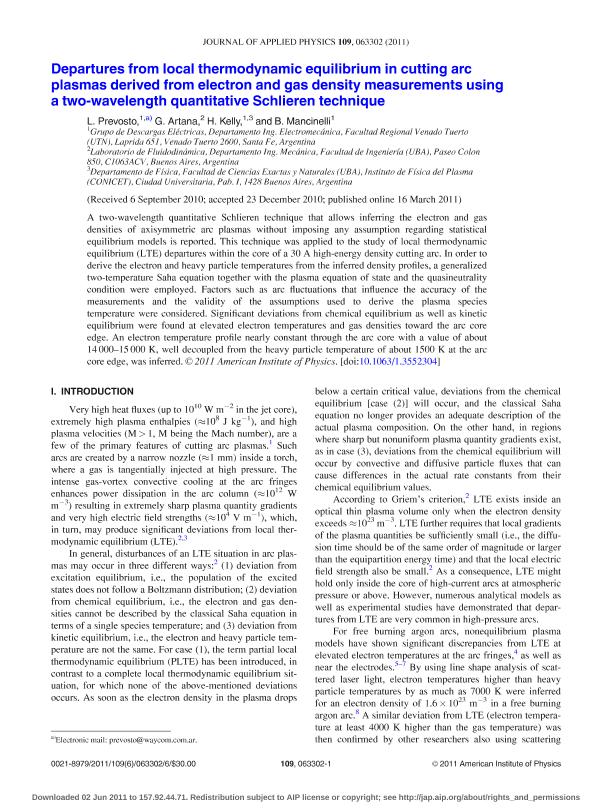Artículo
Departures from local thermodynamic equilibrium in cutting arc plasmas derived from electron and gas density measurements using a two-wavelength quantitative schlieren technique
Fecha de publicación:
03/2011
Editorial:
American Institute of Physics
Revista:
Journal of Applied Physics
ISSN:
0021-8979
Idioma:
Inglés
Tipo de recurso:
Artículo publicado
Clasificación temática:
Resumen
A two-wavelength quantitative Schlieren technique that allows inferring the electron and gas densities of axisymmetric arc plasmas without imposing any assumption regarding statistical equilibrium models is reported. This technique was applied to the study of local thermodynamic equilibrium (LTE) departures within the core of a 30 A high-energy density cutting arc. In order to derive the electron and heavy particle temperatures from the inferred density profiles, a generalized two-temperature Saha equation together with the plasma equation of state and the quasineutrality condition were employed. Factors such as arc fluctuations that influence the accuracy of the measurements and the validity of the assumptions used to derive the plasma species temperature were considered. Significant deviations from chemical equilibrium as well as kinetic equilibrium were found at elevated electron temperatures and gas densities toward the arc core edge. An electron temperature profile nearly constant through the arc core with a value of about 14000-15000 K, well decoupled from the heavy particle temperature of about 1500 K at the arc core edge, was inferred.
Palabras clave:
Plasma Torch
,
Schlieren
Archivos asociados
Licencia
Identificadores
Colecciones
Articulos(INFINA)
Articulos de INST.DE FISICA DEL PLASMA
Articulos de INST.DE FISICA DEL PLASMA
Articulos(SEDE CENTRAL)
Articulos de SEDE CENTRAL
Articulos de SEDE CENTRAL
Citación
Prevosto, Leandro; Artana, Guillermo Osvaldo; Kelly, Hector Juan; Mancinelli, Beatriz Rosa; Departures from local thermodynamic equilibrium in cutting arc plasmas derived from electron and gas density measurements using a two-wavelength quantitative schlieren technique; American Institute of Physics; Journal of Applied Physics; 109; 6; 3-2011; 1-6
Compartir
Altmétricas




